Divine Comedy + Decameron discussion

This topic is about
The Divine Comedy
Dante's Commedia
>
10-16 Feb.: Inferno VIII-XIV
More from the same source:
" Dante himself shows that he may have been influenced by Islam in writing the Divine ComedyN= Miguel Asin Palacios put forth the controversial idea in 1919 that Dante got the idea for writing about a journey through Hell, then eventually up to Heaven, from two famous Islamic works of literature: the Isra and the Mirage The former is about Mohammed's journey through Hell, while the latter is about his Ascension from Jerusalem to the Throne of Gods These two Arabic works of literature struck Palacios as prototypes for Dante's Divine Comedy, in which Dante goes on a very similar journey In addition, Palacios found that the links between the Muslim legend and Dante's poem also included picturesque, descriptive, and even episodic similarities.[26] For example, Palacios drew a comparison between the city of Dis and the city in the Moslem Hell, for both were described by the authors as being a city of fire. Furthermore, the tombs of the heretics are described by Dante as being a bed of fire, each harboring coffins of red hot iron; similarly, Mohammed saw an ocean of fire, on whose shore were cities in flames with thousands of red hot coffins.[27] Thus, Palacios concluded that Dante used the Isra and the Mirai as outlines in critics his journey through Hell, and eventually up to Heavenly While this assumption may be true, one can argue that Dante used these Arabic works as references in order to write a better, more complete Christian story. Thus, he possibly wanted there to exist a similar story to the Muslim legend, only one which was written by a Christian and that was superior to the Muslim story. If this intention was Dante's plan, then his attitude towards Islam is only corroborated, for he attempted to prove how any piece of Christian literature could emulate and surpass any Arabic literature, even if the works involved were coveted Muslim legends."
" Dante himself shows that he may have been influenced by Islam in writing the Divine ComedyN= Miguel Asin Palacios put forth the controversial idea in 1919 that Dante got the idea for writing about a journey through Hell, then eventually up to Heaven, from two famous Islamic works of literature: the Isra and the Mirage The former is about Mohammed's journey through Hell, while the latter is about his Ascension from Jerusalem to the Throne of Gods These two Arabic works of literature struck Palacios as prototypes for Dante's Divine Comedy, in which Dante goes on a very similar journey In addition, Palacios found that the links between the Muslim legend and Dante's poem also included picturesque, descriptive, and even episodic similarities.[26] For example, Palacios drew a comparison between the city of Dis and the city in the Moslem Hell, for both were described by the authors as being a city of fire. Furthermore, the tombs of the heretics are described by Dante as being a bed of fire, each harboring coffins of red hot iron; similarly, Mohammed saw an ocean of fire, on whose shore were cities in flames with thousands of red hot coffins.[27] Thus, Palacios concluded that Dante used the Isra and the Mirai as outlines in critics his journey through Hell, and eventually up to Heavenly While this assumption may be true, one can argue that Dante used these Arabic works as references in order to write a better, more complete Christian story. Thus, he possibly wanted there to exist a similar story to the Muslim legend, only one which was written by a Christian and that was superior to the Muslim story. If this intention was Dante's plan, then his attitude towards Islam is only corroborated, for he attempted to prove how any piece of Christian literature could emulate and surpass any Arabic literature, even if the works involved were coveted Muslim legends."
The Kitab al Miraj (Arabic: كتاب المعراج "Book of the Ascension") is a Muslim book concerned with Muhammad's ascension into Heaven (known as the Miraj), following his miraculous one-night journey from Mecca to Jerusalem (the Isra). The book is divided into 7 chapters, and was written in Arabic using the Naskh script.
Kitab al-Miraj is believed to have been written by Abu'l-Qasim 'Abdalkarîm bin Hawâzin bin 'Abdalmalik bin Talhah bin Muhammad al-Qushairî al-Nisaburi أبو القاسم عبد الكريم بن هوازن بن عبد الملك بن طلحة بن محمد القشيري (born 376 - died 465 A.H.).
In the second half of the 13th century, the book was translated into Latin (as Liber Scale Machometi) and Spanish, and soon thereafter (in 1264) into Old French.[1] Its Islamic depictions of Hell are believed by some scholars to have been a major influence on Dante's 14th century masterpiece, the Divine Comedy, including Miguel Asin Palacios, and Enrico Cerulli .
Kitab al-Miraj is believed to have been written by Abu'l-Qasim 'Abdalkarîm bin Hawâzin bin 'Abdalmalik bin Talhah bin Muhammad al-Qushairî al-Nisaburi أبو القاسم عبد الكريم بن هوازن بن عبد الملك بن طلحة بن محمد القشيري (born 376 - died 465 A.H.).
In the second half of the 13th century, the book was translated into Latin (as Liber Scale Machometi) and Spanish, and soon thereafter (in 1264) into Old French.[1] Its Islamic depictions of Hell are believed by some scholars to have been a major influence on Dante's 14th century masterpiece, the Divine Comedy, including Miguel Asin Palacios, and Enrico Cerulli .
Dante Alighieri and Islam
Author: Roberta Fedele
Considered an emblem of the Christian Middle Ages and a central author of the Western tradition, Italian writer Dante Alighieri unintentionally reveals a lot about the influence of Islamic thought and models on Christian Europe. This is especially true of his masterpiece, “The Divine Comedy”, regarded as a prodigy of Italian literature and one of the most refined Christian and European literary works.
In the 1920s, Spanish historian Miguel Asín Palacios raised an animated diatribe in the European cultural and academic milieu with the publication of the book “Islamic Eschatology in the Divine Comedy”, an attempt to read “The Divine Comedy” noncanonically while underlining its Islamic sources and Dante’s attraction to Arab culture. Comparing Dante’s poem to Arab manuscripts narrating the Night Journey, known as Isra and Miraj, Palacios noticed relevant similarities at a symbolic and formal level.“The Divine Comedy” describes Dante's journey in the realms of the afterlife and represents allegorically the soul's journey toward God. On the other hand, the Isra and Miraj describes the Night Journey from Makkah to Jerusalem and the Ascension to Heaven that Prophet Muhammad (peace be upon him) took, both physically and spiritually, during a single night around the year 621. Mentioned in the Qur’an, the Isra and Miraj became a source of inspiration for several Muslim authors who gave their own interpretations of the argument in their literary works. The controversy regarding the Islamic sources of the most cherished Christian poem lessened when experts found out that in the second half of the 13th century a manuscript narrating the Ascension to Heaven had been translated into Latin, as “Liber Schalae Machometi”, and also into Spanish and old French, making almost certain Dante’s knowledge about the manuscript. Besides, Arabic culture was well known and widespread in Tuscany in the 14th century, and Brunetto Latini, the Florentine ambassador to Toledo in 1260, can be theoretically considered the intermediary between Dante and “Liber Schalae Machometi”.In “Liber Schalae Machometi”, the most similar manuscript to “The Divine Comedy” carefully studied by Maria Corti, The Prophet (pbuh) performs his journey under the guidance of Archangel Gabriel, following an itinerary from the eight circles of Paradise to the seven earths of Hell where he receives the mandate to tell people what he has seen in order to save them from eternal damnation. The same mandate is given to Dante in “The Divine Comedy” where, just like in the Muslim Hell, the damned souls are ordered in different circles and inflicted with abominable pains according to the law of retaliation. Both stories are narrated in the first person and provide detailed descriptions of the lower world characterized by seas, liquids, pools, smells, flames, ice and animals. Even the element of light, essential in Dante’s “Paradise”, evokes the studies on the metaphysics of light performed by Arab thinkers.In his literary works Dante quotes many names related to the Muslim world, such as Saladin, Avicenna, Averroe’, Brunetto Latini and Pietro Ispano, and reveals a deep knowledge of the works belonging to Muslim scientists and philosophers. Several scholars also underline the assonances between Dante’s style, known as “dolce stil novo”, and the figure of the angelic woman and the conceptions of love expressed by Muslim poets narrating mystical experiences and soul journeys in the afterlife.During the dark centuries of the European Middle Ages, Islamic civilization represented the heart of science, philosophy, art and technology, acquiring moreover the merit of having preserved the knowledge of the Classical Era. The Islamic world encompassed a huge empire – from the Caucasus to North Africa and Spain – thus representing the only civilization that simultaneously bordered Western Europe, Byzantium, China and India, reinvigorating and binding together separate traditions. The main bridges of transmission of Islamic knowledge to Europe were Spain and Sicily where an intense Arab culture developed. The human symbols of this cultural assimilation were Frederick II of Sicily, with his amazing Arab-style court, and Alfonso X of Castile, who encouraged the translation and adaptation of Moorish philosophy and science.As Dante’s case illustrates, Islamic culture has been an essential element of confrontation and an inspiring source for Western society whose contribution has been underestimated in comparison to the contributions of the Greek and Roman traditions.
Author: Roberta Fedele
Considered an emblem of the Christian Middle Ages and a central author of the Western tradition, Italian writer Dante Alighieri unintentionally reveals a lot about the influence of Islamic thought and models on Christian Europe. This is especially true of his masterpiece, “The Divine Comedy”, regarded as a prodigy of Italian literature and one of the most refined Christian and European literary works.
In the 1920s, Spanish historian Miguel Asín Palacios raised an animated diatribe in the European cultural and academic milieu with the publication of the book “Islamic Eschatology in the Divine Comedy”, an attempt to read “The Divine Comedy” noncanonically while underlining its Islamic sources and Dante’s attraction to Arab culture. Comparing Dante’s poem to Arab manuscripts narrating the Night Journey, known as Isra and Miraj, Palacios noticed relevant similarities at a symbolic and formal level.“The Divine Comedy” describes Dante's journey in the realms of the afterlife and represents allegorically the soul's journey toward God. On the other hand, the Isra and Miraj describes the Night Journey from Makkah to Jerusalem and the Ascension to Heaven that Prophet Muhammad (peace be upon him) took, both physically and spiritually, during a single night around the year 621. Mentioned in the Qur’an, the Isra and Miraj became a source of inspiration for several Muslim authors who gave their own interpretations of the argument in their literary works. The controversy regarding the Islamic sources of the most cherished Christian poem lessened when experts found out that in the second half of the 13th century a manuscript narrating the Ascension to Heaven had been translated into Latin, as “Liber Schalae Machometi”, and also into Spanish and old French, making almost certain Dante’s knowledge about the manuscript. Besides, Arabic culture was well known and widespread in Tuscany in the 14th century, and Brunetto Latini, the Florentine ambassador to Toledo in 1260, can be theoretically considered the intermediary between Dante and “Liber Schalae Machometi”.In “Liber Schalae Machometi”, the most similar manuscript to “The Divine Comedy” carefully studied by Maria Corti, The Prophet (pbuh) performs his journey under the guidance of Archangel Gabriel, following an itinerary from the eight circles of Paradise to the seven earths of Hell where he receives the mandate to tell people what he has seen in order to save them from eternal damnation. The same mandate is given to Dante in “The Divine Comedy” where, just like in the Muslim Hell, the damned souls are ordered in different circles and inflicted with abominable pains according to the law of retaliation. Both stories are narrated in the first person and provide detailed descriptions of the lower world characterized by seas, liquids, pools, smells, flames, ice and animals. Even the element of light, essential in Dante’s “Paradise”, evokes the studies on the metaphysics of light performed by Arab thinkers.In his literary works Dante quotes many names related to the Muslim world, such as Saladin, Avicenna, Averroe’, Brunetto Latini and Pietro Ispano, and reveals a deep knowledge of the works belonging to Muslim scientists and philosophers. Several scholars also underline the assonances between Dante’s style, known as “dolce stil novo”, and the figure of the angelic woman and the conceptions of love expressed by Muslim poets narrating mystical experiences and soul journeys in the afterlife.During the dark centuries of the European Middle Ages, Islamic civilization represented the heart of science, philosophy, art and technology, acquiring moreover the merit of having preserved the knowledge of the Classical Era. The Islamic world encompassed a huge empire – from the Caucasus to North Africa and Spain – thus representing the only civilization that simultaneously bordered Western Europe, Byzantium, China and India, reinvigorating and binding together separate traditions. The main bridges of transmission of Islamic knowledge to Europe were Spain and Sicily where an intense Arab culture developed. The human symbols of this cultural assimilation were Frederick II of Sicily, with his amazing Arab-style court, and Alfonso X of Castile, who encouraged the translation and adaptation of Moorish philosophy and science.As Dante’s case illustrates, Islamic culture has been an essential element of confrontation and an inspiring source for Western society whose contribution has been underestimated in comparison to the contributions of the Greek and Roman traditions.
The paper intends to bring out the fact that Dante wrote the great poem because he wanted to write something
great at par with the fabled Mairaj Nama or Mohammad’s [PBUH] Ascension to Heaven.
Dante was not happy with thefact that Islam was becoming popular in the middle ages and its influence was felt on the culture of the time and wanted towrite something that would negate its effects. The paper also wants to show that Dante wrote Divine Comedy after havingread the translations of the Arabic accounts of Mohammad,s [PBUH] Ascension to heaven by Bonaventura da Siena, anItalian notary at the court of Castilian court of Alfonsonso el Sabio and was brought to the forefront byProfessor Miguel Asin Palacois
,a Spanish scholar’s book La
Eschatologia Musulmana en La Divina Comedyshocked the world of Dante scholars in 1919 when he said that Dante borrowed the central idea of his Commedia fromIslamic tradition of Al-miraj.
http://www.academia.edu/4114047/INFLU...
great at par with the fabled Mairaj Nama or Mohammad’s [PBUH] Ascension to Heaven.
Dante was not happy with thefact that Islam was becoming popular in the middle ages and its influence was felt on the culture of the time and wanted towrite something that would negate its effects. The paper also wants to show that Dante wrote Divine Comedy after havingread the translations of the Arabic accounts of Mohammad,s [PBUH] Ascension to heaven by Bonaventura da Siena, anItalian notary at the court of Castilian court of Alfonsonso el Sabio and was brought to the forefront byProfessor Miguel Asin Palacois
,a Spanish scholar’s book La
Eschatologia Musulmana en La Divina Comedyshocked the world of Dante scholars in 1919 when he said that Dante borrowed the central idea of his Commedia fromIslamic tradition of Al-miraj.
http://www.academia.edu/4114047/INFLU...
Thank you very much for this Reem..
The introduction to one of my editions does mention the Libro de la Escala, which was then translated into French (Livre de leschiele Mahomet) and into Latin (Liber Scalae Machometi). by the Italian Buenaventura from Siena, around 1264... This book arrived in Italy around 1306 where Dante would have seen it..
The introduction to one of my editions does mention the Libro de la Escala, which was then translated into French (Livre de leschiele Mahomet) and into Latin (Liber Scalae Machometi). by the Italian Buenaventura from Siena, around 1264... This book arrived in Italy around 1306 where Dante would have seen it..
 Thanks, Reem!
Thanks, Reem!A few thoughts on VIII-XIV:
- I quite like that he's making a point of how Dante is physical in a way the "shadows" are not. Of course, eternal punishment through boiling or burning or tossing-about-by-wind wouldn't work if you had a normal physical body that could be broken down.
- Dante's sympathy for the sufferers really comes and goes depending on what he thought of the people in life, doesn't it? So far I'm counting Pride and Wrath... Smugness isn't one of the mortal sins, is it?
- It's intriguing that Dante has Virgil (as a representative of pre-Christianity) prompt Dante to reason about why things are sinful - and refers to Aristotle as well. As harsh as some ideas may seem 700 years later, and as disdainful as he is towards both Islam and Christian heretics, there's more to it than just "These things are bad because GOD SAID SO." In more than one way, Dante's hell is both populated and run by humans - the choices they make, the things they do to each other, and the stories they tell about it (describing it, justifying it, defying it).
- The suicide forest really is brilliant writing, and quite horrific as well. Not just because of their current situation (immobile, completely at the mercy of random tourists bumbling by and snapping off bits of you) but their ultimate fate come resurrection:
Like others for our spoils shall we return;
But not that any one may them revest,
For 'tis not just to have what one casts off.
Here we shall drag them, and along the dismal
Forest our bodies shall suspended be,
Each to the thorn of his molested shade.
...ouch.
- And much like Dante credits morality to more than just God, he also credits other gods with power; Mars still holds power over Florence.
- A question: Twice in these cantos, Dante refers to nameless characters who aren't mentioned in the notes of my edition. In canto IX, Virgil refers to bringing back a soul from the circle of Judas shortly after he was shorn from his flesh (ie somewhere around the events of the NT). Later in the same canto, "one sent from Heaven" comes to open the door to Dis for Dante and Virgil and chastise the fallen angels guarding it. Are these references to any particular characters/people?
 Bjorn wrote: "I quite like that he's making a point of how Dante is physical in a way the "shadows" are not. Of course, eternal punishment through boiling or burnin..."
Bjorn wrote: "I quite like that he's making a point of how Dante is physical in a way the "shadows" are not. Of course, eternal punishment through boiling or burnin..."I hadn't paid attention to this (now I will!) but the question of the corporeality of those sent to Hell is very interesting. For edification purposes I imagine the sinners would need to be more than shadows and have bodies similar enough to those of living human beings to experience pain. This question must have been seriously discussed by the Church...
It makes me wonder how Dante's epic poem was received by the Vatican - not so much on the political points he was making but on the religious aspects he illustrated (or invented?)...
 ReemK10 (Paper Pills) wrote: "This sounds like the city of Abu Dis in Jerusalem..."
ReemK10 (Paper Pills) wrote: "This sounds like the city of Abu Dis in Jerusalem..."Very interesting. The wiki page on the Dis mentions the Dis Pater, "Roman god of the underworld, later subsumed by Pluto or Hades."
They also say that the Dis, with its "towers, gates, walls, ramparts, bridges, and moats," is "an antithesis to the heavenly city, as for instance described by St. Augustine in his City of God."
http://en.wikipedia.org/wiki/Dis_%28D...

Lower Hell, inside the walls of Dis, illustration by Stradanus
 Bjorn wrote: "A question: Twice in these cantos, Dante refers to nameless characters who aren't mentioned in the notes of my edition. In canto IX, Virgil refers to bringing back a soul from the circle of Judas shortly after he was shorn from his flesh (ie somewhere around the events of the NT). Later in the same canto, "one sent from Heaven" comes to open the door to Dis for Dante and Virgil and chastise the fallen angels guarding it. Are these references to any particular characters/people?"
Bjorn wrote: "A question: Twice in these cantos, Dante refers to nameless characters who aren't mentioned in the notes of my edition. In canto IX, Virgil refers to bringing back a soul from the circle of Judas shortly after he was shorn from his flesh (ie somewhere around the events of the NT). Later in the same canto, "one sent from Heaven" comes to open the door to Dis for Dante and Virgil and chastise the fallen angels guarding it. Are these references to any particular characters/people?"The notes in Ciardi say for the former that Erichtho is "a sorceress drawn from Lucan (Pharsalia, VI, 508ff)" and that "Erichtho called up the spirit in order to foretll the outcome of the campaign between Pompey and Caesar. There is no trace of the legend in which Virgil is chosen for the descent; Virgil, in fact, was still alive at the time of the battle of Pharsalia." The latter is only described in the notes as a messenger from God.
 ReemK10 (Paper Pills) wrote: "The Kitab al Miraj (Arabic: كتاب المعراج "Book of the Ascension") is a Muslim book concerned with Muhammad's ascension into Heaven (known as the Miraj), following his miraculous one-night journey f..."
ReemK10 (Paper Pills) wrote: "The Kitab al Miraj (Arabic: كتاب المعراج "Book of the Ascension") is a Muslim book concerned with Muhammad's ascension into Heaven (known as the Miraj), following his miraculous one-night journey f..."I have been trying to find Le Livre de l'échelle de Mahomet but it's out of print. >:( This one is a translation of the Latin version but there are many other retellings of Muhammad's nocturnal voyage. Apparently it's still being widely read as part of islamic celebrations?
The Bibliothèque National de France (BnF) has a beautiful XV-century Ottoman manuscript with illustrations of the Miraj:
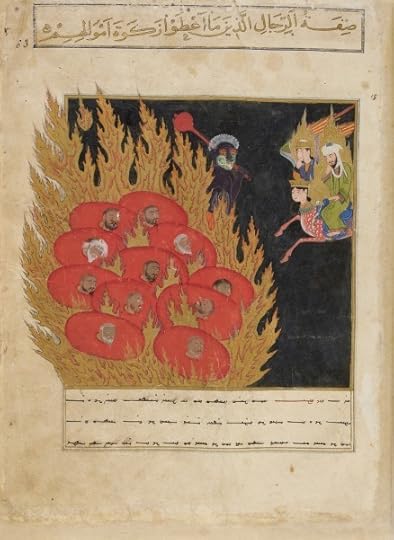
Punishment of those who didn't pay the Zakat (Muhammad is riding Al-Buraq)
http://expositions.bnf.fr/islam/livre...
(click on "introduction audiovisuelle" for a very short film showing the illustrations. The commentary in French narrates the story)
http://gallica.bnf.fr/ark:/12148/btv1...
Book Portrait wrote: "ReemK10 (Paper Pills) wrote: "The Kitab al Miraj (Arabic: كتاب المعراج "Book of the Ascension") is a Muslim book concerned with Muhammad's ascension into Heaven (known as the Miraj), following his ..."
What a great find BP. It's very rare to find illustrations of Prophet Mohammad. You are so good at finding these links!
I think if you want the story of the night journey, there is nothing better than the original source.
The Quran: Surat Al-Israa'
http://quran.com/17
You can hear the audio, choose from several translations and have access to different languages.
http://www.islamicity.com/mosque/isra...
https://www.islamicity.com/articles/A...
What a great find BP. It's very rare to find illustrations of Prophet Mohammad. You are so good at finding these links!
I think if you want the story of the night journey, there is nothing better than the original source.
The Quran: Surat Al-Israa'
http://quran.com/17
You can hear the audio, choose from several translations and have access to different languages.
http://www.islamicity.com/mosque/isra...
https://www.islamicity.com/articles/A...
Book Portrait wrote: "ReemK10 (Paper Pills) wrote: "The Kitab al Miraj (Arabic: كتاب المعراج "Book of the Ascension") is a Muslim book concerned with Muhammad's ascension into Heaven (known as the Miraj), following his ..."
The book was first translated from Arabic into Spanish Libro de la Escala under the directions of the King Alfonso X, and then, from the Spanish into French and into Latin...
http://www.persee.fr/web/revues/home/...
http://www.letralia.com/170/ensayo01.htm
The book was first translated from Arabic into Spanish Libro de la Escala under the directions of the King Alfonso X, and then, from the Spanish into French and into Latin...
http://www.persee.fr/web/revues/home/...
http://www.letralia.com/170/ensayo01.htm
I also found this:
There is a section on Dante and Beatrice and the numerology of the number 9. Also about the language of courtly love. This is interesting!!!
http://konekrusoskronos.wordpress.com...
There is a section on Dante and Beatrice and the numerology of the number 9. Also about the language of courtly love. This is interesting!!!
http://konekrusoskronos.wordpress.com...
Book Portrait wrote: "ReemK10 (Paper Pills) wrote: "The Kitab al Miraj (Arabic: كتاب المعراج "Book of the Ascension") is a Muslim book concerned with Muhammad's ascension into Heaven (known as the Miraj), following his ..."
Lovely illustration. You and Reem are so good at fishing sources.
Lovely illustration. You and Reem are so good at fishing sources.
Kalli, we may get into trouble for being 16/17 messages into week 2, but this kind of info can't wait, can it? lol Proustitute needs to give you moderator status again!!!
Sorry, just one more before the week officially starts.
Kalli, BP, Richard,
Dante says,"All cried, get Filippo Argenti!"
and in the notes, Hollander mentions that Filippo Argenti had his horse's hooves shod in silver.
Do you think that this is the horse that Proust mentioned that was fed flowers? I forgot where we read about it in ISOLT, and if we already thought it was this Filippo Argenti or not?
Kalli, BP, Richard,
Dante says,"All cried, get Filippo Argenti!"
and in the notes, Hollander mentions that Filippo Argenti had his horse's hooves shod in silver.
Do you think that this is the horse that Proust mentioned that was fed flowers? I forgot where we read about it in ISOLT, and if we already thought it was this Filippo Argenti or not?
 ReemK10 (Paper Pills) wrote: "I think if you want the story of the night journey, there is nothing better than the original source.
ReemK10 (Paper Pills) wrote: "I think if you want the story of the night journey, there is nothing better than the original source.The Quran: Surat Al-Israa'..."
Thanks for these links Reem. I knew that the Miraj is based on Surat 17.1 but I hadn't seen the Hadiths! The details of the otherworld in the Christian religion were similarly only briefly mentioned in the Bible before being expanded on in the gospels and popular culture (tales and testimonies of those who claimed to have visited Hell).
I read somewhere that the legendary journey of an Irish knight through Purgatory and Paradise, later written by a monk in Saint Patrick's Purgatory: A Twelfth Century Tale of a Journey to the Other World and retold many times (including by Marie de France in Saint Patrick's Purgatory: A Poem), was a key inspiration for painters, in particular Hieronymus Bosch and his Garden of Earthly Delights.
http://en.wikipedia.org/wiki/Tractatu...
http://en.wikipedia.org/wiki/St_Patri...

1666 map of Station Island, Lough Derg with the entrance to the Otherworld marked "Caverna Purgatory" (entrance to an actual cave)
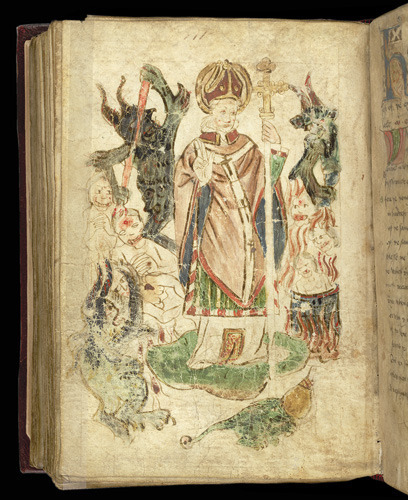
Drawing of Patrick as a bishop surrounded by souls in Purgatory, preceding the Saint Patrick's Purgatory
http://www.bl.uk/catalogues/illuminat...
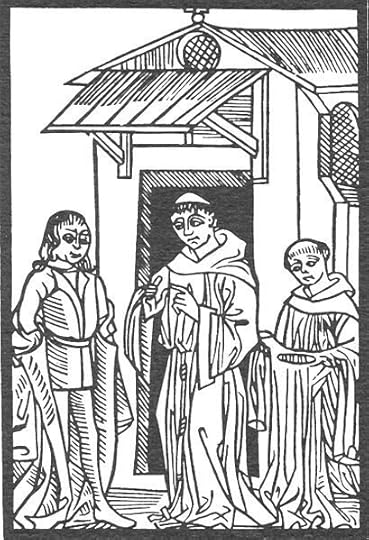
Knight Owein (at the left) listens to the enumerations of the torments of the purgatory by the prior (in the center) by Claude Noury (1506)
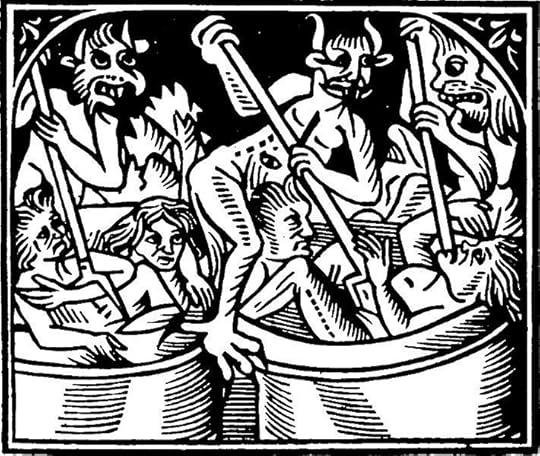
The torment of the cauldron, as seen by Knight Owein during his trip through St. Patrick's Purgatory by Claude Noury (1506)

The Garden of Eartly Delights by Bosch
 Canto VIII Illustrations
Canto VIII Illustrations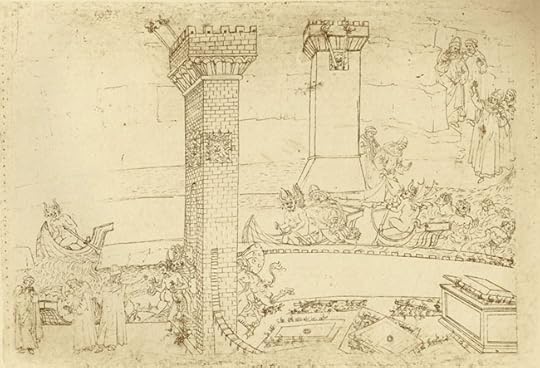
Sandro Botticelli - Entrance to the city of Dis
Slightly bigger pic: http://www.worldofdante.org/media/ima...
Segando se ne va V antica prora
Dell' acqua più che non suol con altrui.
INFERNO, C. VIII, v. 29 E 30.

Gustave Doré - Phlegyas ferries Dante and Virgil across swamp of Styx
Perchè'l Maestro accorto lo sospinse,
Dicendo : « Via costà con gli altri canif!
INFERNO, C. VIII. v. 41 E 42

Gustave Doré - Virgil pushes Filippo Argenti back into the River Styx
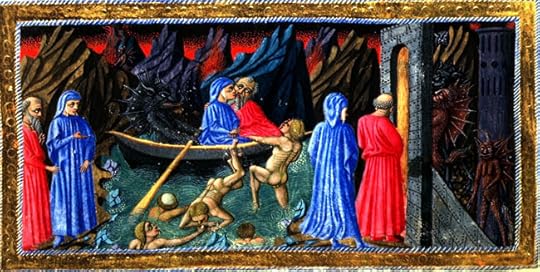
Priamo della Quercia - Punishment of Wrathful; Entrance to Dis
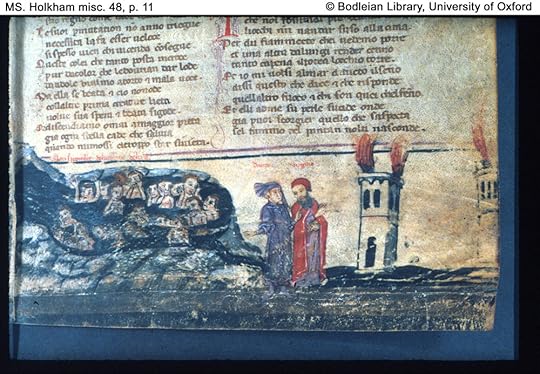
Bodleian Library - The wrathful and the sullen in Styx; Dante and Virgil before the tower with two lights; the tower of Dis with one light.

Bodleian Library - Phlegyas ferries Dante and Virgil; Filippo Argenti beside the boat; the wrathful in Styx; Dante watches Virgil parleying with a devil before the City of Dis.

William Blake: Inferno, Canto VIII, 30-64, Virgil repelling Filippo Argenti from the boat
 Canto VIII illustrations (con'd)
Canto VIII illustrations (con'd)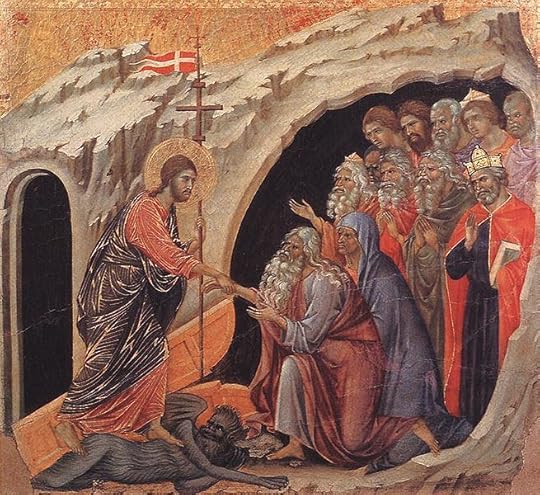
Duccio di Buoninsegna - Descent to Hell (between 1308 and 1311)
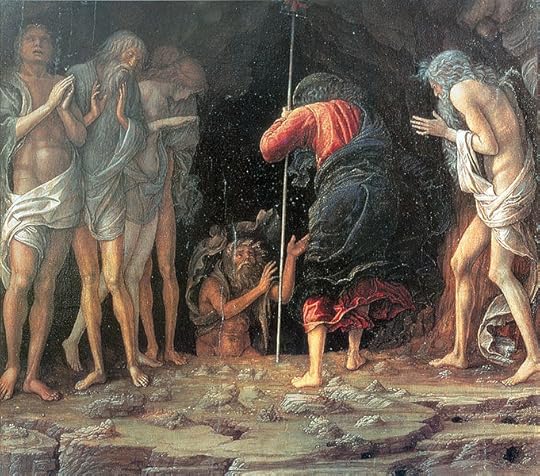
Andrea Mantegna - Christ's Descent into Limbo (1470–75)
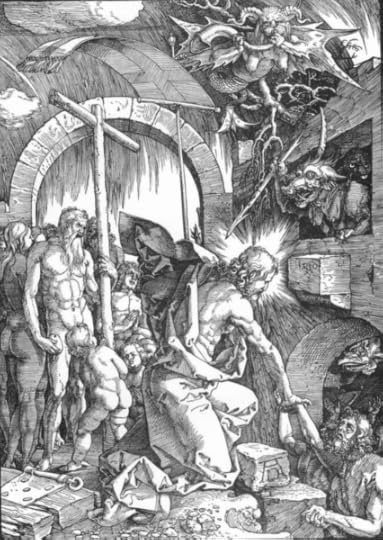
Albrecht Dürer - Christ's Descent into Limbo (1510)
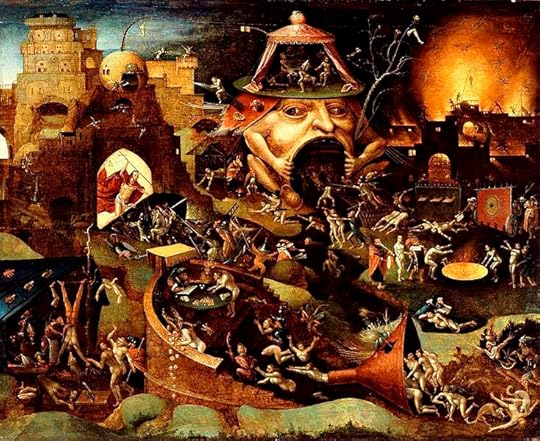
Follower of Hieronymus Bosch - Christ in Limbo (c. 1575)
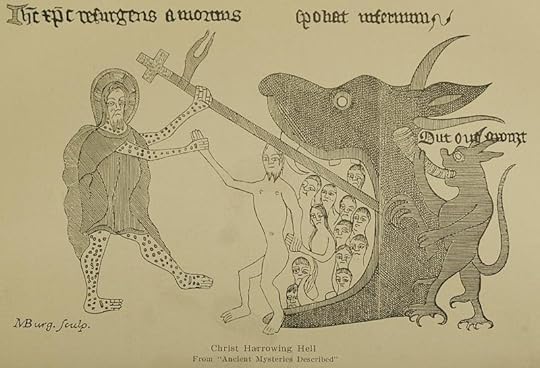
Michael Burghers - "Descent into Hell" (early XVIII)
In the context of Christian theology, the Harrowing of Hell (Latin: Descensus Christi ad Inferos, "the descent of Christ into hell") is the Old English and Middle English term for the triumphant descent of Christ into Hell (or Hades) between the time of his Crucifixion and his Resurrection when he brought salvation to all of the righteous who had died since the beginning of the world (excluding the damned).
http://en.wikipedia.org/wiki/Harrowin...
http://en.wikipedia.org/wiki/Limbo
 Canto IX illustrations
Canto IX illustrations
Sandro Botticelli - City of Dis and the heretics
Slightly bigger pic: http://www.worldofdante.org/media/ima...

Doré - Virgil pointing out the Erinyes

Doré - Celestial messenger dispersing the devils
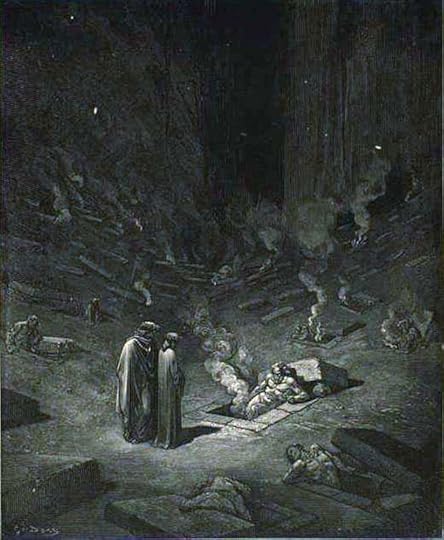
Doré - Dante and Virgil among the heretics
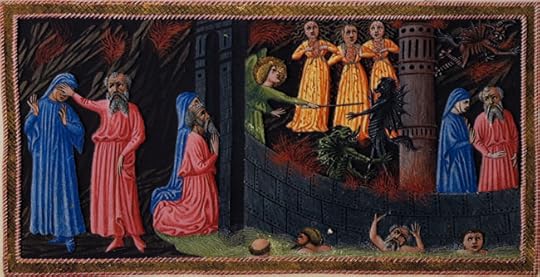
Priamo della Quercia - Entrance to Dis; Devils and the Furies
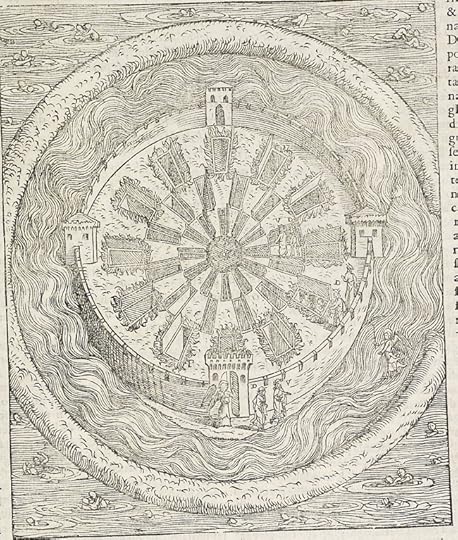
Vellutello, Alessandro (commissioner) - Overview of Dis and the tombs of the heretics

Virgil shields Dante's eyes; the three Furies stand in front of the tower of Dis.
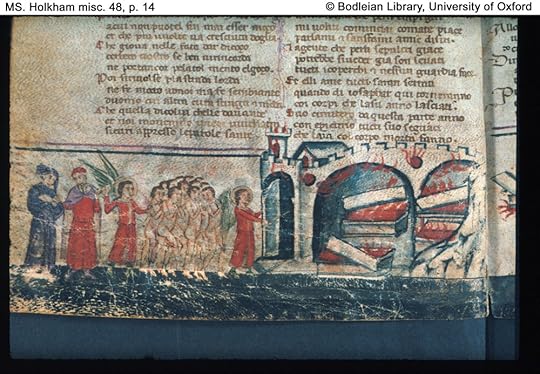
Dante and Virgil watch the Heavenly messenger approach; a group of souls; the Heavenly messenger opens the gate of Dis; within the city, sacrophagi from which flames issue

William Blake: Inferno, Canto IX, 44-64, The Angel an the Gate of Dis
 Canto IX illustrations (cont'd)
Canto IX illustrations (cont'd)Just as at Arles, where Rhone becomes a marsh,
just as at Pola, near Quarnero's gulf,
that closes Italy and bathes its borders,
the sepulchers make all the plain uneven,
so they did here on every side, except
that here the sepulchers were much more harsh;
Arles - Nécropole des Alyscamps
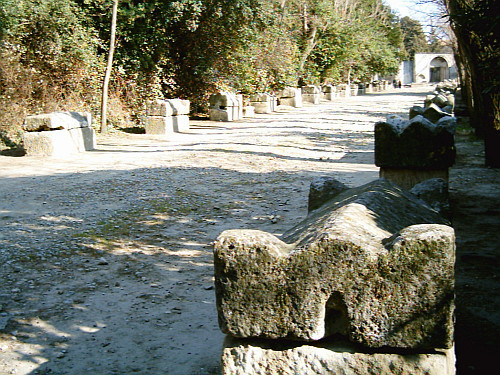
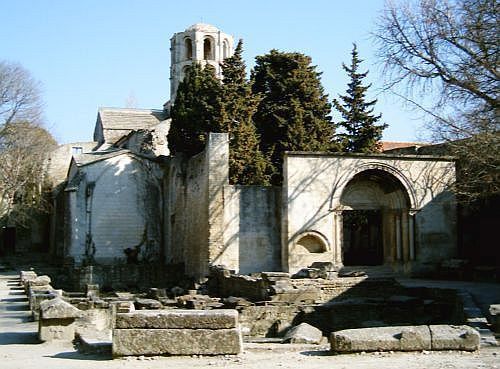
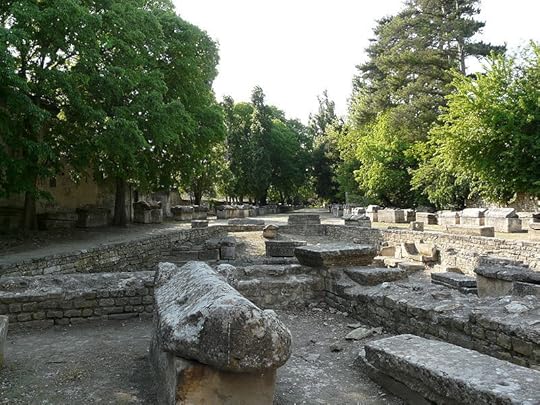
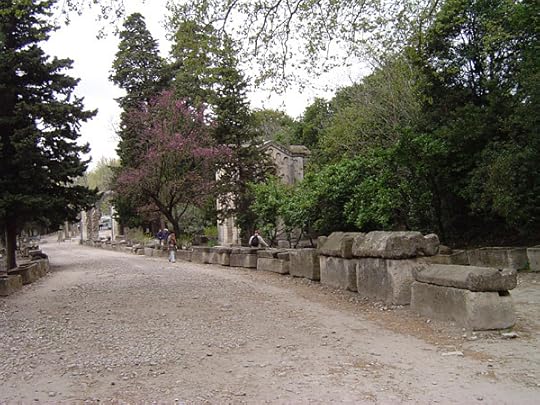
The Alyscamps is a large Roman necropolis, which is a short distance outside the walls of the old town of Arles, France. It was one of the most famous necropolises of the ancient world. The name comes from the Provençal Occitan word Aliscamps, who comes from the Latin Elisii Campi (that is, in French, Champs-Élysées; in English Elysian Fields). They were famous in the Middle Ages and are referred to by Ariosto in Orlando Furioso and by Dante in the Inferno.
Roman cities traditionally forbade burials within the city limits. It was therefore common for the roads immediately outside a city to be lined with tombs and mausoleums; the Appian Way outside Rome provides a good example. The Alyscamps was Arles' main burial ground for nearly 1,500 years. It was the final segment of the Aurelian Way leading up to the city gates and was used as a burial ground for well-off citizens, whose memorials ranged from simple sarcophagi to elaborate monuments.
http://en.wikipedia.org/wiki/Alyscamps

Paul Gaugin - Les Alyscamps (1888)
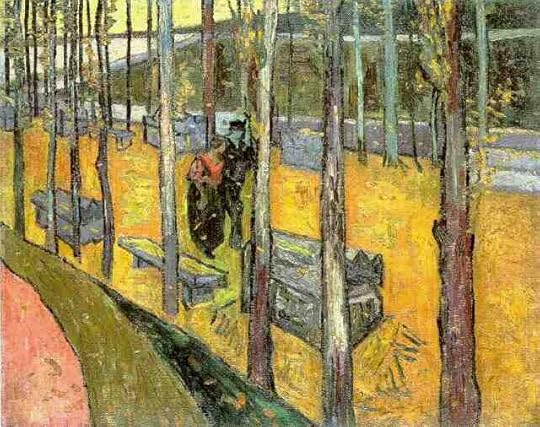
Van Gogh - Les Alyscamps (1888)
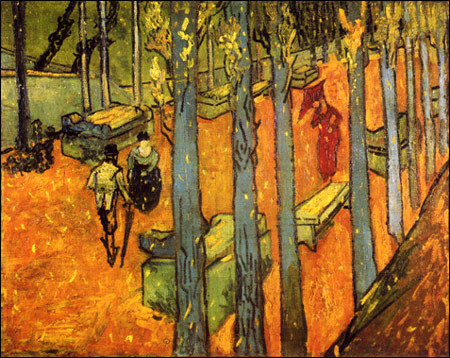
Van Gogh - Les Alyscamps, Falling Autumn Leaves (1888)
ReemK10 (Paper Pills) wrote: "Dante Alighieri and Islam
Author: Roberta Fedele
Considered an emblem of the Christian Middle Ages and a central author of the Western tradition, Italian writer Dante Alighieri unintentionally re..."
Reem,
Thank you very much for drawing attention to Miguel Asín Palacios. He had been a friend of my family. He was the tutor and protector of the Arabist in our family who followed and pursued his studies and academic career under Asín.
Author: Roberta Fedele
Considered an emblem of the Christian Middle Ages and a central author of the Western tradition, Italian writer Dante Alighieri unintentionally re..."
Reem,
Thank you very much for drawing attention to Miguel Asín Palacios. He had been a friend of my family. He was the tutor and protector of the Arabist in our family who followed and pursued his studies and academic career under Asín.
Kalliope wrote: "ReemK10 (Paper Pills) wrote: "Dante Alighieri and Islam
Author: Roberta Fedele
Considered an emblem of the Christian Middle Ages and a central author of the Western tradition, Italian writer Dant..."
Fortune struck when this info was uncovered, and you turned out to be related to this Spanish historian by a small degree of separation!
BP great finds!!
Author: Roberta Fedele
Considered an emblem of the Christian Middle Ages and a central author of the Western tradition, Italian writer Dant..."
Fortune struck when this info was uncovered, and you turned out to be related to this Spanish historian by a small degree of separation!
BP great finds!!
 Canto X illustrations
Canto X illustrations
The punishment of the heretics

Dante and Virgil before Farinata
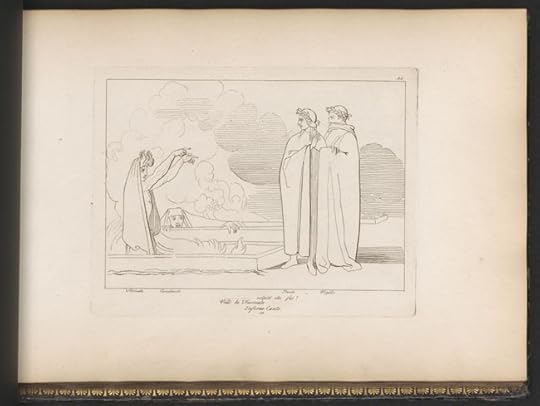
Flaxman, John - Farinata rises from his tomb
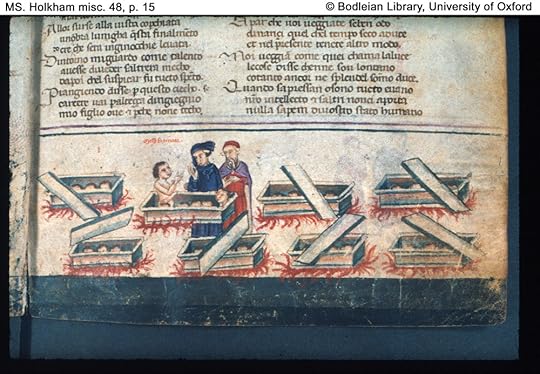
Dante talks to farinata as Virgil stands behind him; Cavalcante in the same sarcophagus; other sarcophagi, containing heads of heretics, are surrounded by flames.
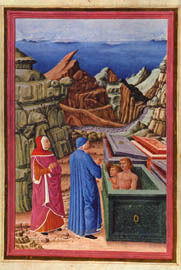
Guglielmo Girardi (1478 Miniature, Biblioteca Apostolica Vaticana)

William Blake - Canto X
 Canto X illustrations (cont'd)
Canto X illustrations (cont'd)Farinata degli Uberti
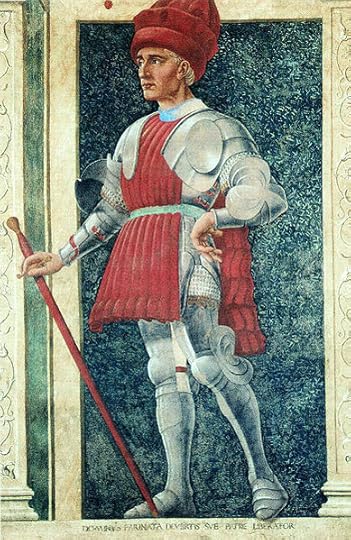
Painting by Andrea del Castagno depicting Farinata degli Uberti. Villa Carducci, Florence
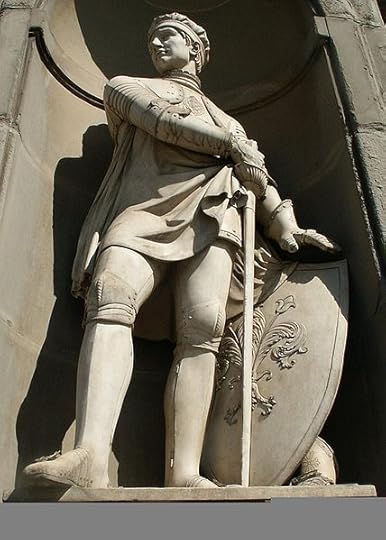
Statue on the facade of the Uffizi Gallery
http://en.wikipedia.org/wiki/Farinata...
Battle of Montaperti
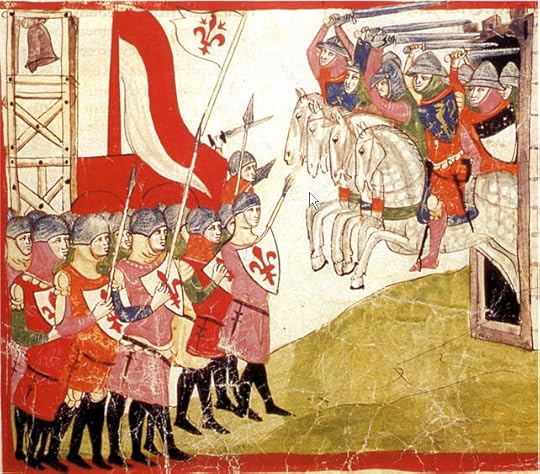
Battle of Montaperti, workshop of Pacino da Bonaguida
The Battle of Montaperti was fought on September 4, 1260, between Florence and Siena in Tuscany as part of the conflict between the Guelphs and Ghibellines. It gained notoriety for an act of treachery that turned the tide of the battle, which was immortalised by Dante Alighieri in his epic poem Divine Comedy.
http://en.wikipedia.org/wiki/Battle_o...
Guido Cavalcanti
Guido Cavalcanti (between 1250 and 1259 – August 1300) was an Italian poet and troubadour, as well as an intellectual influence on his best friend, Dante Alighieri.
http://en.wikipedia.org/wiki/Guido_Ca...
 Can you guys post alternative translations on Canto IX Lines 58-63? It's when the Furies threaten to summon Medusa.
Can you guys post alternative translations on Canto IX Lines 58-63? It's when the Furies threaten to summon Medusa.Ciaran Carson has:
"Thus said my guide, and he himself turned me,
nor did he trust my hands upon my eyes,
but with his own he further hooded me.
O ye of bright and agile mind, realize
the esoteric meaning hidden threefold
by the veil of these outlandish rhymes!"
Thought it was a striking fourth wall break. So is this about blindness, double blindness (blind leading the blind), and sight? Please, ahem, illuminate me!
 Stephanie wrote: "Can you guys post alternative translations on Canto IX Lines 58-63? It's when the Furies threaten to summon Medusa.
Stephanie wrote: "Can you guys post alternative translations on Canto IX Lines 58-63? It's when the Furies threaten to summon Medusa.Ciaran Carson has:
"Thus said my guide, and he himself turned me,
nor did he tr..."
Yep Dante is addressing the reader and telling us to pay attention to the veiled meaning of what he is saying.
Here is the translation available on Wiki:
Thus said the Master; and he turned me round
Himself, and trusted not unto my hands
So far as not to blind me with his own.
O ye who have undistempered intellects,
Observe the doctrine that conceals itself
Beneath the veil of the mysterious verses!
http://en.wikisource.org/wiki/The_Div...
 Canto XI illustrations
Canto XI illustrations
Dante and Virgil before the tomb of Anastasius II

Dante and Virgil pass the sarcophagus of Pope Anastasius; three terraced, concentric circles filled with souls.

William Blake: Inferno, Canto XI, Scheme of the Circles of Hell
 Canto XII illustrations
Canto XII illustrations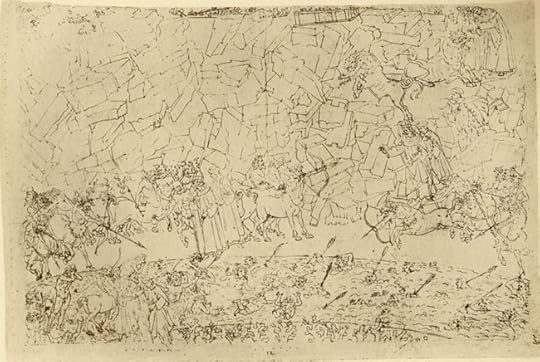
Violent against others
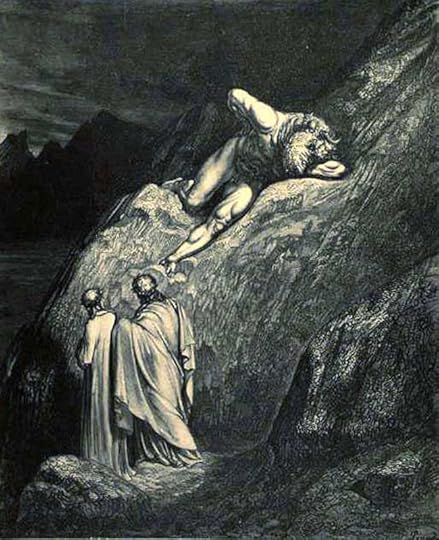
Minotaur
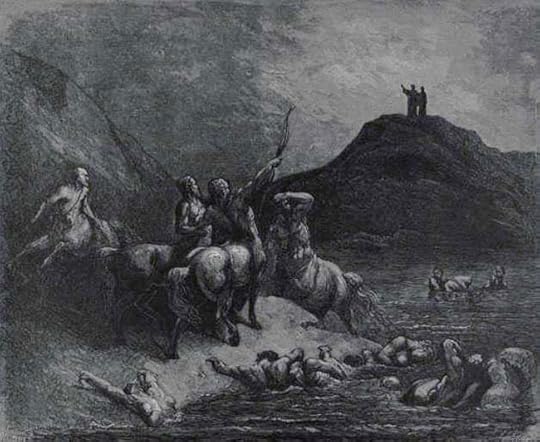
Virgil addressing the centaurs
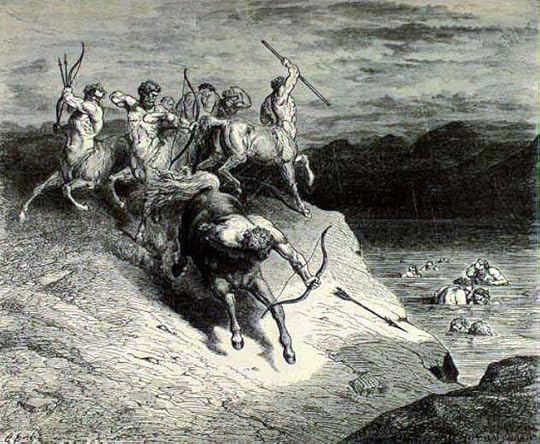
Centaurs patrolling the violent against others

Dante and Virgil before the Minotaur
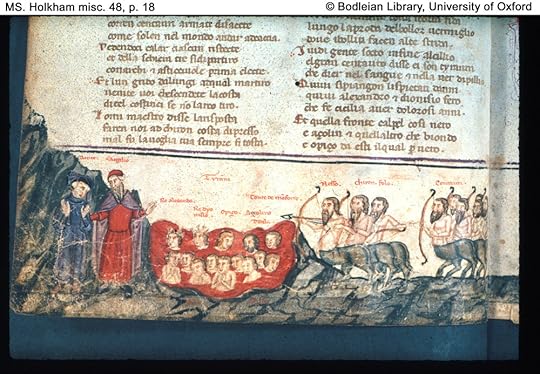
Dante and Virgil meet the three centaurs, who are followed by other centaurs; the tyrants of Phlegethon

William Blake: Inferno, Canto XII,12-28, The Minotaur (The Seventh Circle)
 Thanks Book Portrait, it's disappointing that "threefold" seems to be an embellishment on Carson's part. I'd hoped it was part of the original.
Thanks Book Portrait, it's disappointing that "threefold" seems to be an embellishment on Carson's part. I'd hoped it was part of the original.
 Stephanie wrote: "Thanks Book Portrait, it's disappointing that "threefold" seems to be an embellishment on Carson's part. I'd hoped it was part of the original."
Stephanie wrote: "Thanks Book Portrait, it's disappointing that "threefold" seems to be an embellishment on Carson's part. I'd hoped it was part of the original."It seems so to me too, even looking at the original, here with Dante's World translation:
O voi ch'avete li 'ntelletti sani,
mirate la dottrina che s'asconde
sotto 'l velame de li versi strani
O you possessed of sturdy intellects,
observe the teaching that is hidden here
beneath the veil of verses so obscure
http://www.worldofdante.org/comedy/da...
 Stephanie wrote: "Thanks Book Portrait, it's disappointing that "threefold" seems to be an embellishment on Carson's part. I'd hoped it was part of the original."
Stephanie wrote: "Thanks Book Portrait, it's disappointing that "threefold" seems to be an embellishment on Carson's part. I'd hoped it was part of the original."Ciardi translates it thus:
Men of sound intellect and probity,
weigh with good understanding what lies hidden
behind the veil of my strange allegory!
 Thanks Teresa!
Thanks Teresa!Looks like Ciardi didn't do much better on the 1/3 rhyme: Carson had "realize" and "rhymes" and Ciardi has "probity" and "allegory."
I do like "hidden behind the veil" vs. "hidden three-fold by the veil" - for some reason, the wordplay in Ciardi's is more apparent to me, but I guess that's just me getting tripped up by the "three-fold" again.
 Canto XII illustrations (cont'd)
Canto XII illustrations (cont'd)The Minotaur & Theseus
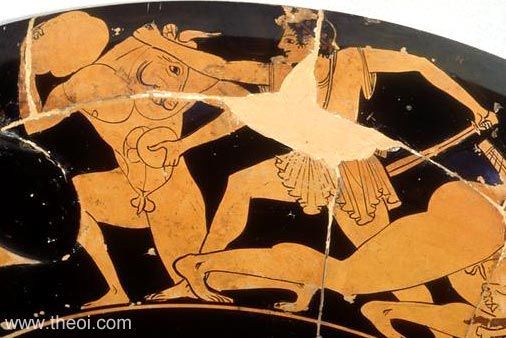
Theseus & the Minotaur, Athenian red figure kylix
C6th B.C., Musée du Louvre, Paris
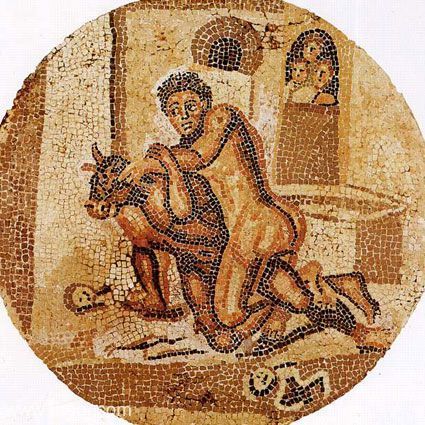
The hero Theseus wrestles the bull-headed Minotaur in the heart of the Labyrinth. Pompeii
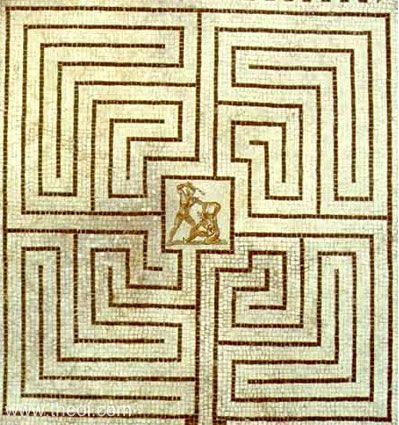
Theseus battles the bull-headed Minotauros in the heart of the labyrinth. Cremona, Villa on the Via Cadolini
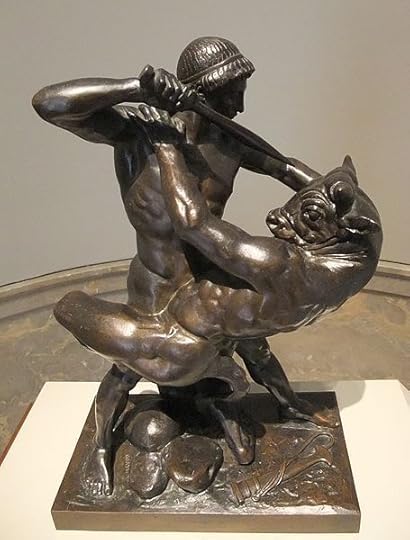
Theseus Slaying Minotaur (1843), bronze sculpture by Antoine-Louis Barye
In Greek mythology, the Minotaur (Ancient Greek: Μῑνώταυρος [miːnɔ̌ːtau̯ros], Latin: Minotaurus, Etruscan Θevrumineś), was a creature with the head of a bull on the body of a man or, as described by Roman poet Ovid, "part man and part bull". He dwelt at the center of the Cretan Labyrinth, which was an elaborate maze-like construction designed by the architect Daedalus and his son Icarus, on the command of King Minos of Crete. The Minotaur was eventually killed by the Athenian hero Theseus.
The term Minotaur derives from the Ancient Greek Μῑνώταυρος, a compound of the name Μίνως (Minos) and the noun ταύρος "bull", translated as "(the) Bull of Minos". In Crete, the Minotaur was known by its proper name, Asterion, a name shared with Minos' foster-father.
In Dante's Inferno, the Minotaur (infamia di Creti, "infamy of Crete"), appears briefly in Dante's Inferno, in Canto 12 (l. 12–13, 16–21), where Dante and his guide Virgil find themselves picking their way among boulders dislodged on the slope, and preparing to enter into the Seventh Circle of Hell.
Dante and Virgil encounter the beast first among the "men of blood": those damned for their violent natures. Many commentators believe that Dante, in a reversal of classical tradition, bestowed the beast with a man's head upon a bull's body.
Giovanni Boccaccio writes of the Minotaur in his literary commentary of the Commedia: "When he had grown up and become a most ferocious animal, and of incredible strength, they tell that Minos had him shut up in a prison called the labyrinth, and that he had sent to him there all those whom he wanted to die a cruel death". Dante Gabriel Rossetti, in his own commentary, compares the Minotaur with all three sins of violence within the seventh circle: "The Minotaur, who is situated at the rim of the tripartite circle, fed, according to the poem was biting himself (violence against oneself) and was conceived in the 'false cow' (violence against nature, daughter of God)."
http://en.wikipedia.org/wiki/Minotaur
http://en.wikipedia.org/wiki/Theseus
http://www.theoi.com/Ther/Minotauros....
 Canto XII (cont'd)
Canto XII (cont'd)Centaurs

A Kentauros (Centaur) casts a rock at the tiger who has slain his mate and infant child. The Kentauris (female centaur) lies dead, bloodied by the raking claws of the beast. The child Kentauris has fallen nearby with its arms stretched out towards the tail of the beast. Altes Museum, Berlin
A centaur (Greek: Κένταυρος, Kéntauros, Latin: centaurus) or hippocentaur is a mythological creature with the head, arms, and torso of a human and the body and legs of a horse.
http://en.wikipedia.org/wiki/Centaur
http://www.theoi.com/Georgikos/Kentau...
Chiron

The Education of Achilles by Chiron' fresco from Herculaneum (Museo Archeologico Nazionale, Naples)
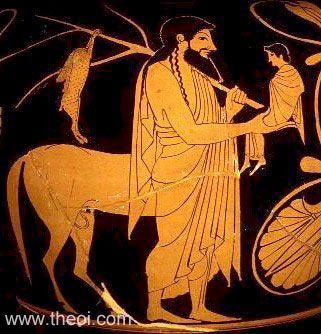
The kentauros (centaur) Kheiron holds the boy Akhilleus in one hand. In the other he grasps a branch hung with a hare, the fruit of the hunt. He is depicted clothed and with the forelegs of a man, unlike the Kentauroi in art. Musée du Louvre

The Education of Achilles by Donato Creti, 1714 (Musei Civici d'Arte Antica, Bologna)
In Greek mythology, Chiron (also Cheiron or Kheiron; Greek: Χείρων "hand") was held to be the superlative centaur among his brethren. Chiron was notable throughout Greek mythology for his kourotrophic (bringer up of boys) nature. A great healer, astrologer, and respected oracle, Chiron was said to be the first among centaurs and highly revered as a teacher and tutor. Among his pupils were many culture heroes: Aeneas, Theseus, Achilles, Jason, Perseus, etc.
http://en.wikipedia.org/wiki/Chiron
http://www.theoi.com/Georgikos/Kentau...
 Canto XII (cont'd)
Canto XII (cont'd)Nessus
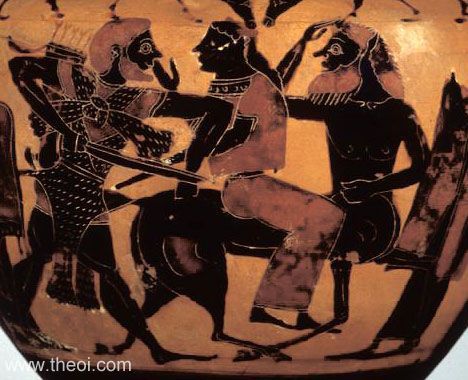
The Centaur Nessus, Heracles & Deianira, Athenian
black-figure hydria C6th B.C., Musée du Louvre
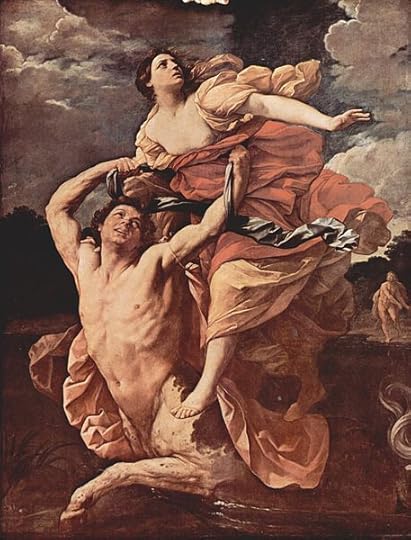
Guido Reni, Abduction of Deianira, 1620-21, Louvre Museum.
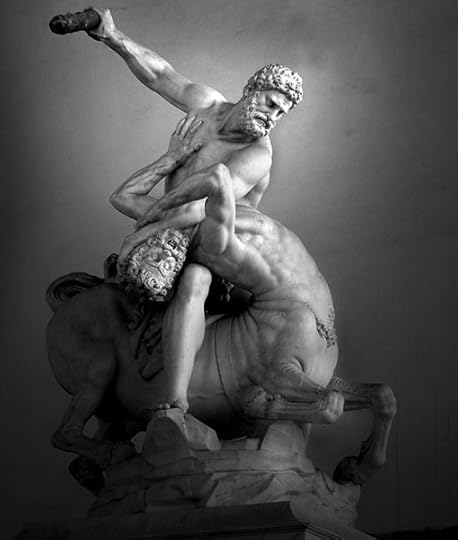
Heracles and Nessus by Giambologna, (1599), Florence.
In Greek mythology, Nessus (Ancient Greek: Νέσσος) was a famous centaur who was killed by Heracles, and whose tainted blood in turn killed Heracles. He was the son of Centauros. He fought in the battle with the Lapiths. He became a ferryman on the river Euenos.
http://en.wikipedia.org/wiki/Nessus_%...
http://www.theoi.com/Georgikos/Kentau...
Phlegethon
In Greek mythology, the river Phlegethon (Φλεγέθων, English translation: "flaming") or Pyriphlegethon (Πυριφλεγέθων, English translation: "fire-flaming") was one of the five rivers in the infernal regions of the underworld, along with the rivers Styx, Lethe, Cocytus, and Acheron. Plato describes it as "a stream of fire, which coils round the earth and flows into the depths of Tartarus." It was parallel to the river Styx. It is said that the goddess Styx was in love with Phlegethon, but she was consumed by his flames and sent to Hades. Eventually when Hades allowed her river to flow through, they reunited.
http://en.wikipedia.org/wiki/Phlegethon
http://www.theoi.com/Khthonios/Potamo...
 Canto XIII illustrations
Canto XIII illustrations
Violent against themselves

Harpies in the wood of the suicides

Dante and Virgil before Pier della Vigna
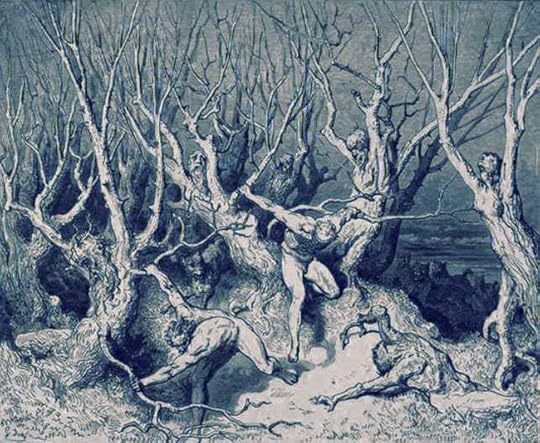
Spendthrifts running through the wood of the suicides

Wood of the suicides and spendthrifts
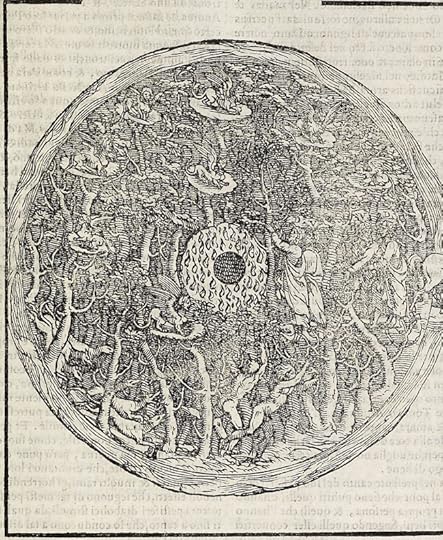
Dante and Virgil in the wood of the suicides

Nessus departing; Dante and Virgil observe a tree in the wood of the suicides bleed after Dante has broken off a twig; Harpies in trees.

Dante and Virgil watch the profligate torn by hounds.
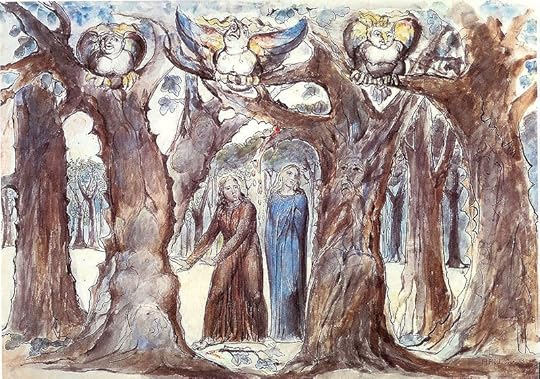
William Blake: Inferno, Canto XIII, 1-45, The Wood of Self-Violators: The Harpies and the Suicides
As I'm looking at the wonderful images that Book Portrait has been posting, and think back to the week one discussion about Dante's vivid geographical portrayals of Hell, I am reflecting on how influential Dante's 3-dimensional descriptions of the circles of Hell have been. There are also increasing numbers of intricate maps from the period just before and after Commedia that map spiritual destinations onto maps of the world -- I'm thinking for example of the Hereford Mappa Mundi (c. 1285, so predating Commedia by a generation -- see http://www.herefordcathedral.org/visi...) , but there are many other examples.
Stephanie wrote: "Thanks Teresa!
Looks like Ciardi didn't do much better on the 1/3 rhyme: Carson had "realize" and "rhymes" and Ciardi has "probity" and "allegory."
I do like "hidden behind the veil" vs. "hidden ..."
Part of Ciardi's balancing act between the rhyme scheme and Dante's original meaning and nuance!
Looks like Ciardi didn't do much better on the 1/3 rhyme: Carson had "realize" and "rhymes" and Ciardi has "probity" and "allegory."
I do like "hidden behind the veil" vs. "hidden ..."
Part of Ciardi's balancing act between the rhyme scheme and Dante's original meaning and nuance!
 Canto XIV illustrations
Canto XIV illustrations
Blasphemers, sodomites, and usurers in the seventh circle
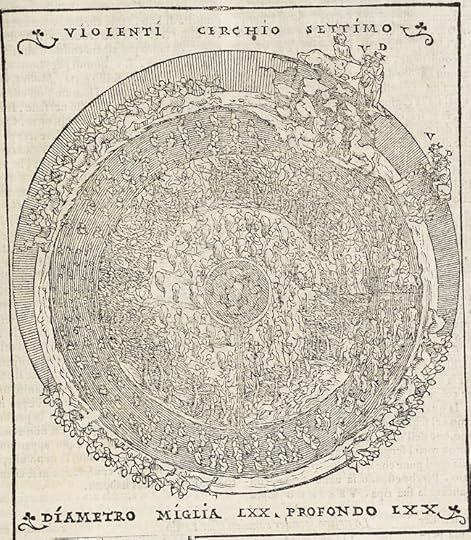
Overview of the seventh circle

Dante and Virgil with Capaneus among the blasphemers and usurers in the rain of fire
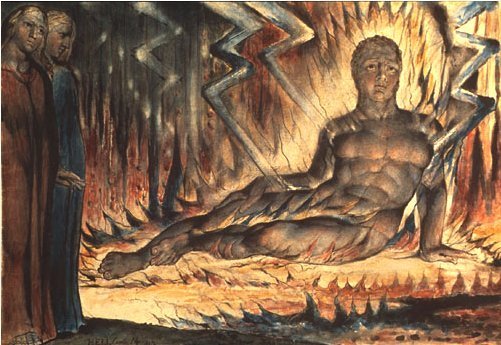
Wiliam Blake: Inferno, Canto XIV, 46-72, Capaneus the Blasphemer
 Kris wrote: "I am reflecting on how influential Dante's 3-dimensional descriptions of the circles of Hell have been. There are also increasing numbers of intricate maps from the period just before and after Comedia that map spiritual destinations onto maps of the world..."
Kris wrote: "I am reflecting on how influential Dante's 3-dimensional descriptions of the circles of Hell have been. There are also increasing numbers of intricate maps from the period just before and after Comedia that map spiritual destinations onto maps of the world..."That's fascinating! I love the detail of the mandrake root:
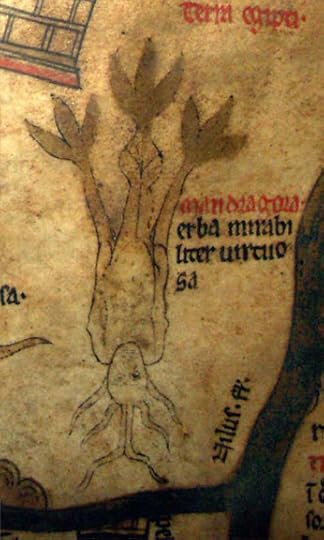
From wiki:
To modern eyes, mappae mundi can look superficially primitive and inaccurate. However, mappae mundi were never meant to be used as navigational charts and they make no pretence of showing the relative areas of land and water. Rather, mappae mundi were schematic and were meant to illustrate different principles. The simplest mappae mundi were diagrams meant to preserve and illustrate classical learning easily.
The larger mappae mundi have the space and detail to illustrate further concepts, such as the cardinal directions, distant lands, Bible stories, history, mythology, flora, fauna and exotic races. In their fullest form, such as the Ebstorf and Hereford maps, they become minor encyclopedias of medieval knowledge.
http://en.wikipedia.org/wiki/Mappa_mundi

Ebstorf Map
Very large pic: http://upload.wikimedia.org/wikipedia...
ETA: very cool interactive map (in German): http://www.uni-lueneburg.de/hyperimag...
Maybe it's linked to the translation I'm reading (1862... possibly still under the influence of the romantics and Anglo-Saxon "weird tales") but the Commedia really feels like an epic journey not just a spiritual journey with edifying illustrations of the punishments sinners will receive in Hell but with a true sense of the dangers and emotions Dante The Pilgrim is going through... It's very easy to picture as a big Lord of the Ring-like extranvaganza with dramatic views of spectacular territories and all the rest... (maybe it's also because I've been admiring all the illustrations I posted! lol).
{Sorry it looks like I'm hogging the thread! I'll go read or something... :)}
 @41Kris wrote: "There are also increasing numbers of intricate maps from the period just before and after Commedia that map spiritual destinations onto maps of the world -- I'm thinking for example of the Hereford Mappa Mundi (c. 1285, so predating Commedia by a generation -- ..."
@41Kris wrote: "There are also increasing numbers of intricate maps from the period just before and after Commedia that map spiritual destinations onto maps of the world -- I'm thinking for example of the Hereford Mappa Mundi (c. 1285, so predating Commedia by a generation -- ..."Thanks, Chris. It was fun to find the Mappa Mundi in the 360 degree tour of the library! (Click on "take the 360 degree tour," then the chained library thumbnail, and finally the circled area within the tour.)
http://www.herefordcathedral.org/visi...
 @40Book Portrait wrote: "Canto XIII illustrations..."
@40Book Portrait wrote: "Canto XIII illustrations..."In the Blake illustration, which figure do we think is Dante, which Virgil? (I actually have the same question for several of the other illustrations/artists. I worked with many of these images in the last online discussion in which I participated, but never resolved the artistic conventions satisfactorily -- especially the extent to which artists had a convention that at least many of them used -- color, head gear, nose, ....
(This question is not just to Book Portrait, but to whomever might be familiar with these illustrations and their conventions.)
Just to add another artist, here are the Salvador Dali links for The Inferno, Cantos VIII - XIV:
The Irascible, Canto VIII
http://www.lockportstreetgallery.com/...
The Furies, Canto IX
http://www.lockportstreetgallery.com/...
Farinata, Canto X
http://www.lockportstreetgallery.com/...
.....Wiki entry on Farinata: http://en.wikipedia.org/wiki/Farinata...
In Dark Limbo, Canto XI
http://www.lockportstreetgallery.com/...
The Minotaur, Canto XII
http://www.lockportstreetgallery.com/...
The Wood and the Suicide, Canto XIII
http://www.lockportstreetgallery.com/...
The Blasphemers, Canto XIV
http://www.lockportstreetgallery.com/...
A link to an essay about these illustrations by Eleanor Hight:
http://dali.parkwestgallery.com/divin...
(My apologies if there are some repeats of illustrations already posted. I didn't double check, but decided to just group the set here. If would have been good if I had managed a quotation with each, but I didn't. I don't (yet) have The Inferno in an ebook edition.)
Book Portrait deserves our thanks for all the work she is doing -- this is time consuming, I know, from having done something similar on a lesser scale. It is up to the rest of us to provide some thought and discussion to go with all the visuals that Dante has been so capable of inspiring.
 One of the questions that haunts me about The Inferno, but that I have never taken the time to think through, is what might be the relative placement and groupings of the rings by a 21st century author/poet -- assuming one exists who might ever posit a hell, particularly one of descending rings.
One of the questions that haunts me about The Inferno, but that I have never taken the time to think through, is what might be the relative placement and groupings of the rings by a 21st century author/poet -- assuming one exists who might ever posit a hell, particularly one of descending rings.Perhaps one of the things that strikes me is Dante's placement of those, like Pontius Pilate, whose "sin" was failure to act. I wonder if all of us whose flagrant misuse of resources may destroy the viability of this planet might belong alongside or far deeper into the abyss. (Yes, I do not intend to give up my warm home.)
I consider Dante's depiction of the depth of hell (view spoiler) is metaphorically most apt.
 Lily wrote: "@40Book Portrait wrote: "Canto XIII illustrations..."
Lily wrote: "@40Book Portrait wrote: "Canto XIII illustrations..."In the Blake illustration, which figure do we think is Dante, which Virgil?"
Though I'm not familiar with these particular conventions, don't you think Virgil is in blue? He's the one who seems to be doing the leading. He also looks more serene, whereas the other figure looks tentative.
 A bit off topic, but the canto about the fallen angels banished to Hell for rebelling against God is one of my favorite and most poetic punishments. Instead of being tortured bodily, they are tortured by having to defend something (the Citadel in Hell) that they may or may not believe in, since their sin was to flee what was good. They can no longer rebel because they are in charge of defending something--a very apt and clever punishment for a group.
A bit off topic, but the canto about the fallen angels banished to Hell for rebelling against God is one of my favorite and most poetic punishments. Instead of being tortured bodily, they are tortured by having to defend something (the Citadel in Hell) that they may or may not believe in, since their sin was to flee what was good. They can no longer rebel because they are in charge of defending something--a very apt and clever punishment for a group.
 Teresa wrote: "don't you think Virgil is in blue?..."
Teresa wrote: "don't you think Virgil is in blue?..."Teresa -- what you write is consistent with this commentary found elsewhere (Wiki) on Blake's painting:
"Blake's painting shows Dante and Virgil walking through a haunted forest at a moment when Dante tears a leaf from a bleeding tree. He drops it in shock on hearing the disembodied words, 'Wherefore tear'st me thus? Is there no touch of mercy in thy breast?'.[1]"
If one looks closely, Blake has a leafed branch in front of the figure in red.
(Illustration is @40.) Note also the figures embedded in the trees, one upside down, another with a crown, the third whose legs and feet seem most visible. The fourth -- not sure.
Books mentioned in this topic
On Late Style: Music and Literature Against the Grain (other topics)Saint Patrick's Purgatory: A Twelfth Century Tale of a Journey to the Other World (other topics)
Saint Patrick's Purgatory: A Poem by Marie de France: Volume 94 (Medieval and Renaissance Texts and Studies) (other topics)
Le Livre de l'échelle de Mahomet (other topics)







we approach the city known as Dis,
with its vast army and its burdened citizens"
And I: "Master, I can clearly see its mosques
within the ramparts, glowing red
as if they'd just been taken from the fire."
And he to me:"The eternal fire
that burns inside them here in nether Hell
makes them show red, as you can see.
At last we reached the moats
dug deep around the dismal city.
Its walls seemed made of iron.
This sounds like the city of Abu Dis in Jerusalem: Abu Dis or Abu Deis (Arabic: أبو ديس) is a Palestinian town in the Jerusalem Governorate of the Palestinian National Authority bordering Jerusalem.
Jerusalem was rebuilt with a moat.Da 9:25
To provide materials for the construction of this fortification, the countryside about Jerusalem within a distance of about 16 km (10 mi) was denuded of its trees. Amazingly, according to Josephus, the over 7-km-long (4.5 mi) fortification was completed in just three days, an undertaking that ordinarily would have required a number of months. Outside the wall of this fortification, 13 places for garrisons were constructed, and their combined circumference amounted to about 2 km (1 mi).—The Jewish War, V, 491-511, 523 (xii, 1, 2, 4).
"Dante Alighieri was a conservative, devout Christian, as well as a strong representative of the attitude of his time Such a perspective is displayed in his book, the Inferno, in which he responds to one of the influences of his time period. the Arabic worlds The influence of Islam was not found in all aspects of medieval society yet its impact, found especially on Christianity and medieval intellectual life, was strongly felt In canto VIII of the Inferno, where Dante describes the existence of mosques in the city of Dis...His placement of these aspects of Arabic culture amongst the sinners of Hell corroborates the notion that Dante held a contemptuous and negative view towards the Muslim world His antipathy for such a culture is based not simply on a prejudiced view that he heldn but rather on his disgust towards its effects on the Christian Church as well as on medieval intellectual lifeW Based on his inclusion of Muslim mosques and leaders in Hell, one can see that the impact on medieval life obviously perturbed Dante, for he would have preferred to have his culture completely devoid of any Islamic influences.
The medieval view of Islam was a hostile one primarily based on fear and prejudice.[01] The basis for this fear evolved from the belief that the Muslim religion posed a serious threat to Christianity's existences for it gave Christianity some unwelcomed competition.[02] In other parts of the world, namely in the East, Islam had a strong foothold, and such a foothold proved to be menacing to Christianity since it showed the world that Christianity was not the absolutes most powerful religion. While the Muslims jeopardized the reputation and stability of the religion of the West, other Christian lands were falling under Arabic ruled One of these countries included Spain, where Muslim occupation, which began in 711 A D , resulted in the religious conversion of the Spanish people and culture.[03] This conquering of Christian soil proved to be another reason why the West felt threatened by the Arabic presence in the world In addition, disdainful views of Mohammed were held by Westerners, for he was regarded as being a false prophet, as a result, Islam was regarded as a heresy, for it appeared to be so radically different from Christianity, and did not involve the worship of the Christian god.[04] In addition, Mohammed was also thought of as being the Devil's tool to end Christianity's spread and success to being instead:
In the Inferno, Dante proves that he was not exempt from this scornful attitude towards the Arabic culture. The first time one encounters any aspects of Muslim culture throughout the Inferno is in canto VIII, when Dante and Virgil are coming upon the city of Dis. As Dante explains to Virgil, "I can already see distinctly a- / master -- the mosques that gleam within the valley, / as crimson as if they had just been drawn out of the fire."[06] In these lines, Dante's contempt for Islam is made quite evident, for he places mosques, the sanctuaries of Muslim worship, in the city of Dis. Had Dante respected the Arabic culture, he would have placed these mosques either in Purgatory or in Heaven, not in Hell amongst all of the other infidels and sinners. Furthermore, he states that the mosques are "as crimson as if they had just been drawn X out of the fire"; thus, Dante suggests that the mosques are ablaze. By indicating that they are in flames, Dante is punishing the followers of Islam, for the fire will bring about the destruction of their mosques. Such a description of these mosques reveals Dante's contempt for Arabic culture." ( Dante and Islam by P. S. The Collegiate School, 1997).
There is more that relates to canto XXVIII, but I will post later when we get to it.